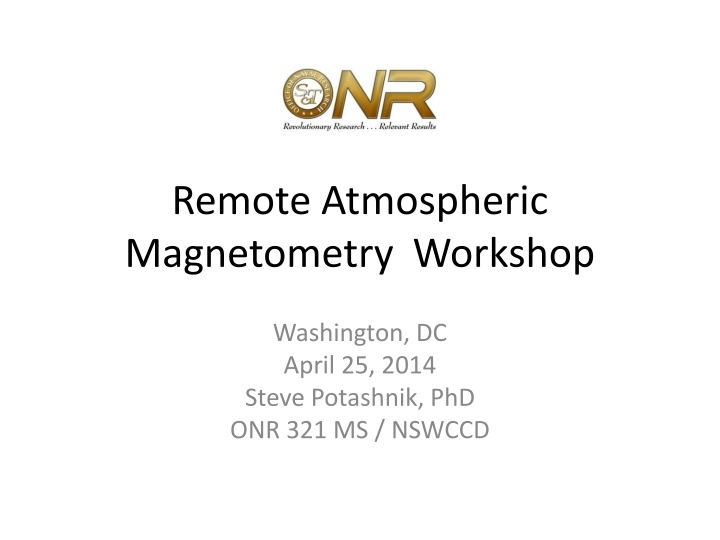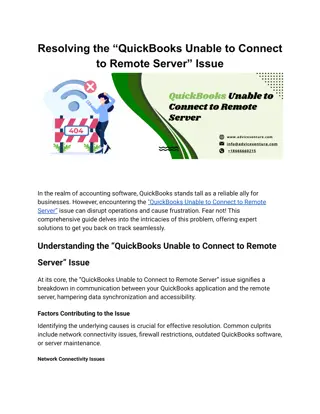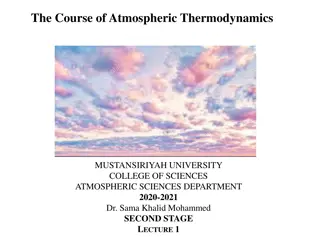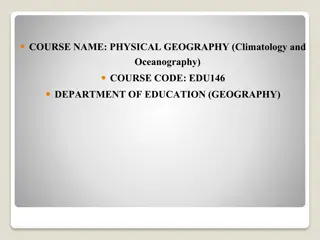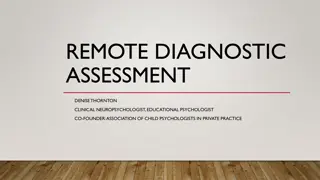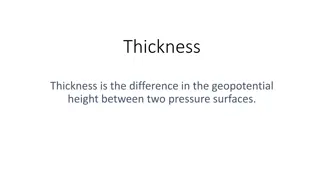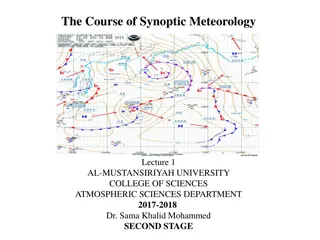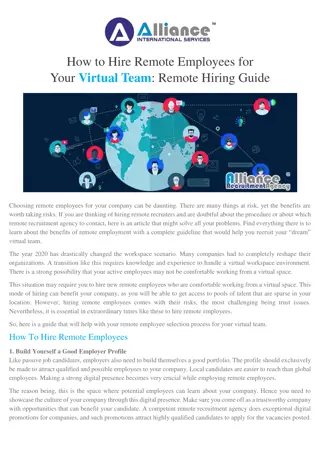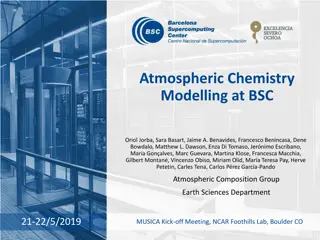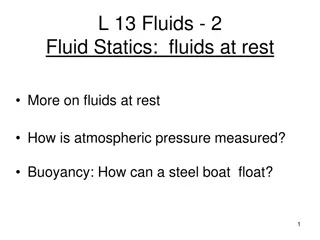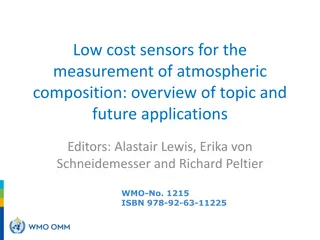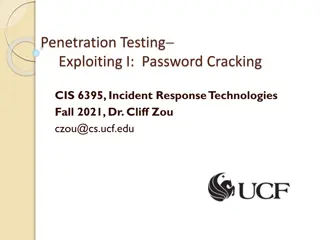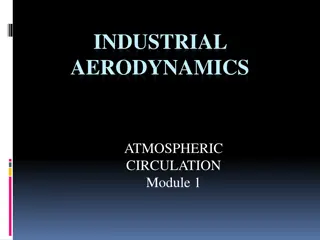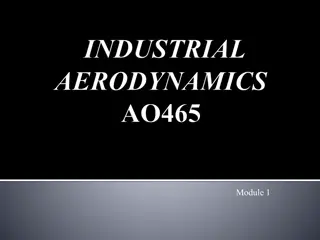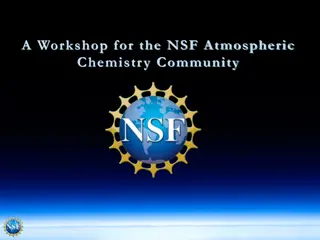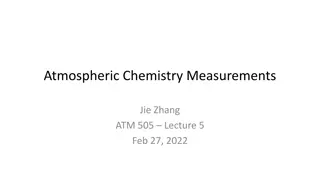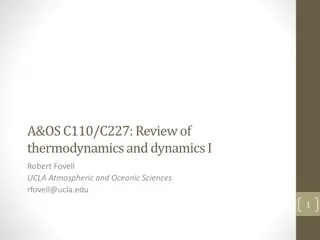Remote Atmospheric Magnetometry Workshop Highlights
This workshop held in Washington, DC in April 2014 brought together experts to explore research possibilities in remote atmospheric magnetometry. Discussions covered motivation, objectives, techniques, and proposals for measuring magnetic fields above ocean surfaces using specific atoms. The event also featured insights on MURI proposals and challenges for atmospheric lasing involving N2. Overall, it provided a platform for interdisciplinary collaboration and exploration of innovative research avenues in the field.
Uploaded on Feb 21, 2025 | 0 Views
Download Presentation

Please find below an Image/Link to download the presentation.
The content on the website is provided AS IS for your information and personal use only. It may not be sold, licensed, or shared on other websites without obtaining consent from the author.If you encounter any issues during the download, it is possible that the publisher has removed the file from their server.
You are allowed to download the files provided on this website for personal or commercial use, subject to the condition that they are used lawfully. All files are the property of their respective owners.
The content on the website is provided AS IS for your information and personal use only. It may not be sold, licensed, or shared on other websites without obtaining consent from the author.
E N D
Presentation Transcript
Remote Atmospheric Magnetometry Workshop Washington, DC April 25, 2014 Steve Potashnik, PhD ONR 321 MS / NSWCCD
Welcome and Motivation Welcome Invitations by recommendation Motivation Magnetic detection ranges are limited by a variety of noise sources. The DoD swork that I released from the 1980 s seemed like a promising starting point. You guys want to write papers and I want to cite papers for proposals, so I m hoping we can find some possibilities worth pursuing. 2
Motivation and Objectives Workshop Objectives Meet each other and nurture interdisciplinary relationships Determine if there are research possibilities for remote atmospheric magnetometry worth pursuing Send me proposals to demonstrate feasibility (guidance on ONR Code 321MS website due in June) ONR Code 321 Maritime Sensing Optics, (Electro)Magnetics, Acoustics Tasked to conduct applied research for ASW, but need basic research for new options Operationally motivated basic research (Navy payoff commensurate with risk) 3
What Atoms to Use Goal: Establish a technique to remotely measure magnetic fields above the ocean surface. - Sensor is on an aircraft or ship - Send out a signal that would interact with the magnetic field at a remote location - Signal propagates back to aircraft or ship to measure the field Abundance (Atoms/cc = X*129Xe) Isotope Spin f fLarmor (Hz/G) 4,258 1H 2.68e13 = 43*129Xe 1/2 2H 4.18e9 = 0.007*129Xe 1 654 3He 1.89e8 = 0.0003*129Xe 1/2 3,244 13C 9.25e13 = 150*129Xe 1/2 1071 14N 4.2e19 = 6.8e7*129Xe 1 308 15N 1.55e17 = 2.5e5*129Xe 1/2 431 17O 4.16e15 = 6.7e3*129Xe 5/2 577 21Ne 1.26e12 = 2*129Xe 3/2 336 2.51e17 = 4e5*129Xe Ar 0 83Kr 3.55e12 = 5.7*129Xe 9/2 164 129Xe 6.18e11 = 1*129Xe 1/2 1,178 4
FY14 MURI Proposal MURI proposal was well received by ONR and there is still interest Possibilities for N2: - Atmospheric Lasing, Dogariu & Miles - Science - 10 mrad beam divergence, CLEO 2013 - coherent retuned light - 100 sec nuclear relaxation time for N2 in Atm (REMUS report, I-3-14) Challenges for N2: - low Larmor frequency - dissociation effects on lifetime - Complex HFS for ground state (2p)4S0 N15 , F = 1, 2 3/2: N14 , F = 1/2, 3/2, 5/2 OSD s Feedback There are very few experimental results that are not highly controversial which would support a major multi-disciplinary effort at this time. The phenomenological basis for this topic must be better understood on a fundamental level before launching a large MURI effort. This topic requires more single investigator advances before being ready for a MURI. 5
Long Range Plan 2-3 proposals: ONR D&I / DARPA Seedling Demonstrate Feasibility - ideally measure a magnetic field in the atmosphere 5 years: MURI / BRC / DURIP / YIP/ ONRG (NICOP) Demonstrate reasonable sensitivity in the lab at 10 ~5 years: Swampworks / DARPA Demonstrate operation on an open test range at an operational distance Improve sensitivity (< 1nT) Increase range (~1 km) / Address turbulence Miniaturize hardware ~5 years: ONR INP/FNC Demonstrate operation on a moving platform Incorporate into aircraft Magnetic noise reduction techniques 6
Closing Thoughts Identify existing methods that can be leveraged or new possibilities to explore for remote magnetometry Define the limiting factors as clearly as possible to focus brainstorming efforts Speculate on reasonable first steps (e.g. add an N2 chapter to the REMAS report?) 7
Proposal Guidelines 321 Maritime Sensing Planning Letters Clearly and concisely describe the nature and objectives of your proposed effort What are the limiting factors that you want to address? Describe the technical approach you will investigate to solve the problem . What expertise will you leverage for this work? How do you hope to overcome the limitation? Indicate the amount of time you need to conduct the research What milestones should I expect to assess progress? Provide an estimated budget broken out by year. Realistic to fund a postdoc or graduate student Include a one- or two-page resume of the lead investigator, which does not count towards the four-page limit described above 8
